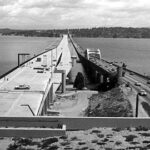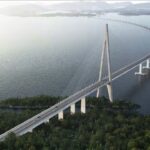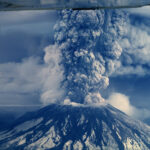In this edition of The Bridge Guy, we commemorate the sinking of the Lacey V. Murrow Memorial Bridge 30 years ago today, November 25. No one was killed or injured by the sinking but the event set back plans for the full re-opening of I-90 by several months. In the early days after the sinking there was some doubt as to whether a replacement bridge would be built at all. Budget issues, uncertainty over Federal funding and a lawsuit put all of that on hold. Not to mention some questions over the safety and integrity of floating bridges in general.
With the old bridge pontoons gone, all that remained of the original bridge was the approach structures. On the west side, little had been started on the renovation. The arch had yet to be widened. With no pontoon to sit on, the transition spans had either been damaged by the sinking or were simply lifted off and removed. But with such a material change to the renovation contract, there was simply no choice but to cancel the contract.
But even with uncertainty surrounding a replacement bridge, planning began in earnest. Thirty years on, I think it is hard to imagine the difficult discussions that were taking place within the Department of Transportation. If funding came through, the Department wanted to be ready. But the new bridge could not simply copy the old bridge. It would need to incorporate the lessons learned from building Third Lake, which was itself based on the old Evergreen Point Bridge design and the lessons learned from the Hood Canal West Half Replacement in 1982.
Eventually work on the design of the replacement bridge began. With the success of the Third Lake design and the recognized expertise that WSDOT had in house for floating bridge design after 50 years in the business, WSDOT proceeded with design almost entirely in house. With the public leaning heavily on the department to restore I-90 as promised, there was some amount of urgency in the task.
As one designer who worked on the replacement bridge recalled during those hectic days in 1991, it was one hell of a way to design a bridge. Preliminary design began as early as December 1990. For nearly a year over a dozen engineers and multiple draftsmen would devote countless hours to the design. By November 1991, the design was completed and would go out for advertisement in early 1992.
Pontoons for the new bridge were built at Concrete Technology in Tacoma. CTC already had a graving dock on site that could accommodate the planned pontoons. The east half Hood Canal pontoons would be built here in the 2000’s and the supplemental stability pontoons for the new Evergreen Point Bridge in the 2010’s. Normally a graving dock site would need to be secured and built in order to build such monstrous concrete pontoons – which would have taken too long for this project.
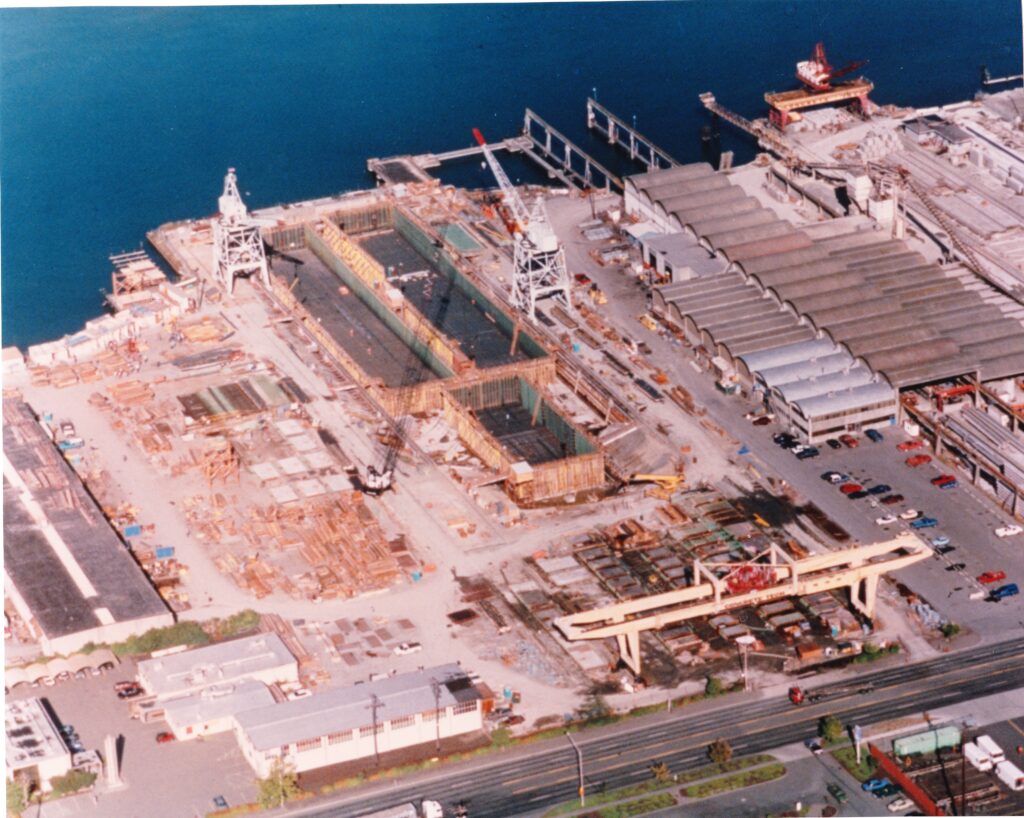
Unlike Third Lake, which was still very much hand drawn, the replacement bridge would be drawn largely with Computer Aided Drafting (CAD). This helped speed up the design process and made changes much easier.
Outwardly, the design of the replacement bridge looks much the same as the original bridge. In some ways you could say it was built new to look old. In the haste to get something designed that worked, less thought was given to new floating bridge concepts and engineers opted for a tried and true concept. Pontoons are 60 feet wide and typically about 360 feet long. The new bridge has 20 pontoons where the original had 22 when it sank. The new pontoons were deeper by about 4 feet on average.
In keeping with the concept from the renovation that access hatches should be accessible by water, the new bridge would employ what are known as “maintenance cells.” These are little bump out cells on the north side of the bridge. Instead of placing the hatch door in the wall of the pontoon, the hatch is placed on top of the maintenance cell. The bump out allows the crew to access the hatches by boat and enter the pontoon while safely separated from traffic.
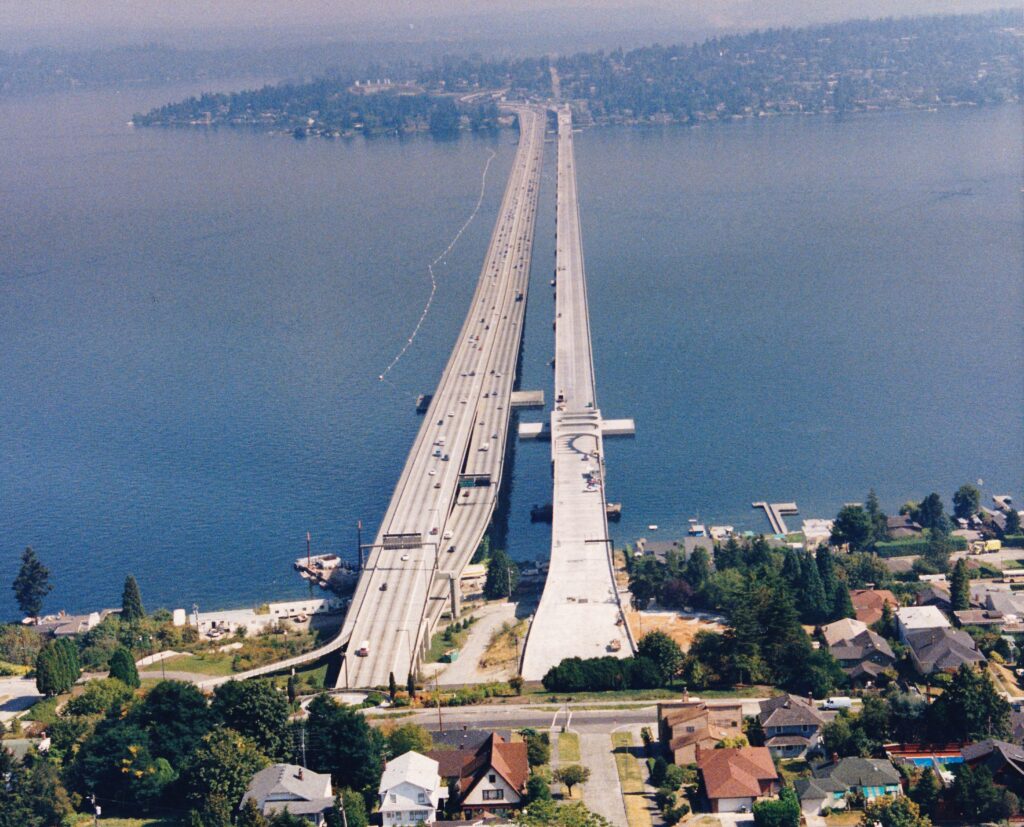
On shore, the concrete approaches that were designed for the renovation were re-bid for the replacement contract unchanged. The west arch would be widened and the deck replaced. Work had already begun on the west approach deck trusses and that work would be completed. To this day, the only original portions of the bridge that date back to 1940 are the three deck trusses at the west end and the signature arch spans and corresponding piers.
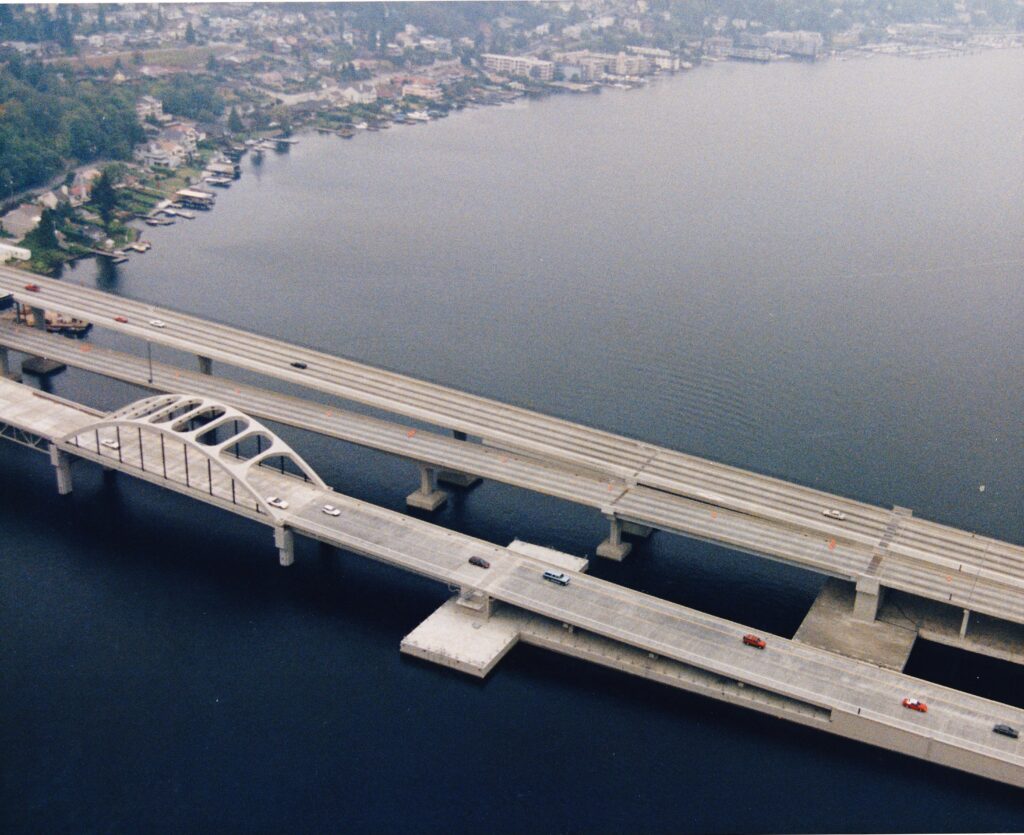
Originally, the transition spans were simple deck trusses with a grid deck. During the renovation, the grid deck was to be removed and replaced with a widened concrete deck. Since the west transition was damaged during the sinking, both spans were replaced. Instead of a truss, engineers opted for steel box girders.
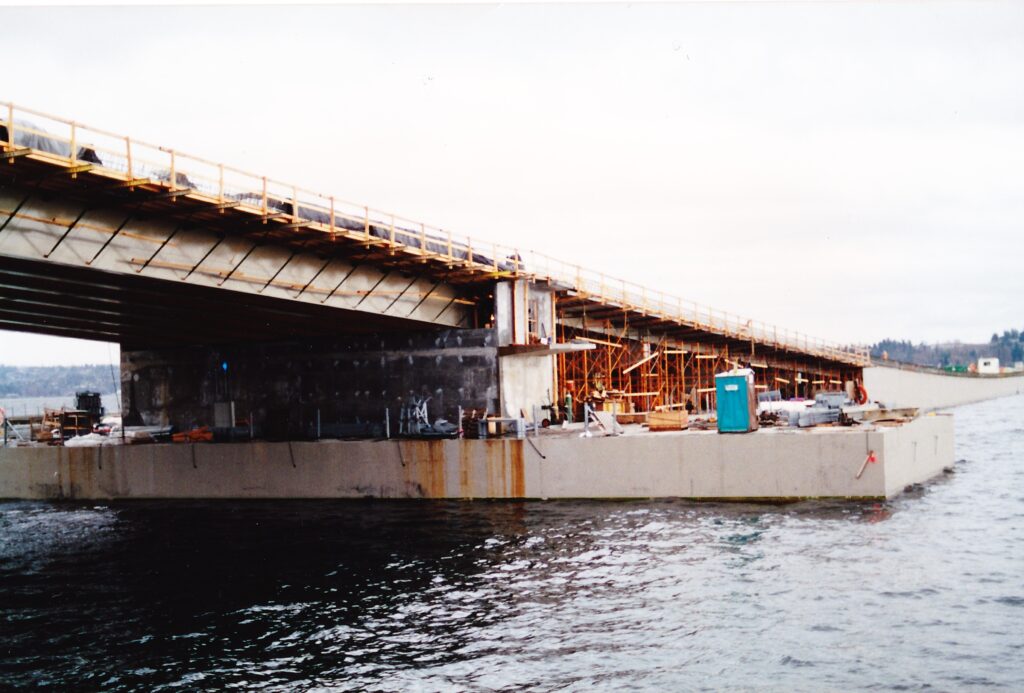
On the floating portion, the original bridge used steel trusses to support the roadway in the highrise sections. On the replacement bridge, prestressed concrete girders and conventional piers and crossbeams were used instead. Gone was the concrete parapet rail on the pontoon deck in these areas. Instead, the now standard phillystran cable rail was used. This was done because the concrete rail would trap lake splash and rainwater on the pontoon. This led to standing water around the hatches. If there is a way into something, water will find it. The dynamic effects of water sloshing on the deck during a storm were also thought to be less than desirable. On the Evergreen Point Bridge, this parapet had scuppers cut into it at first to help drain trapped water. Eventually the whole rail was removed as a weight saving measure.
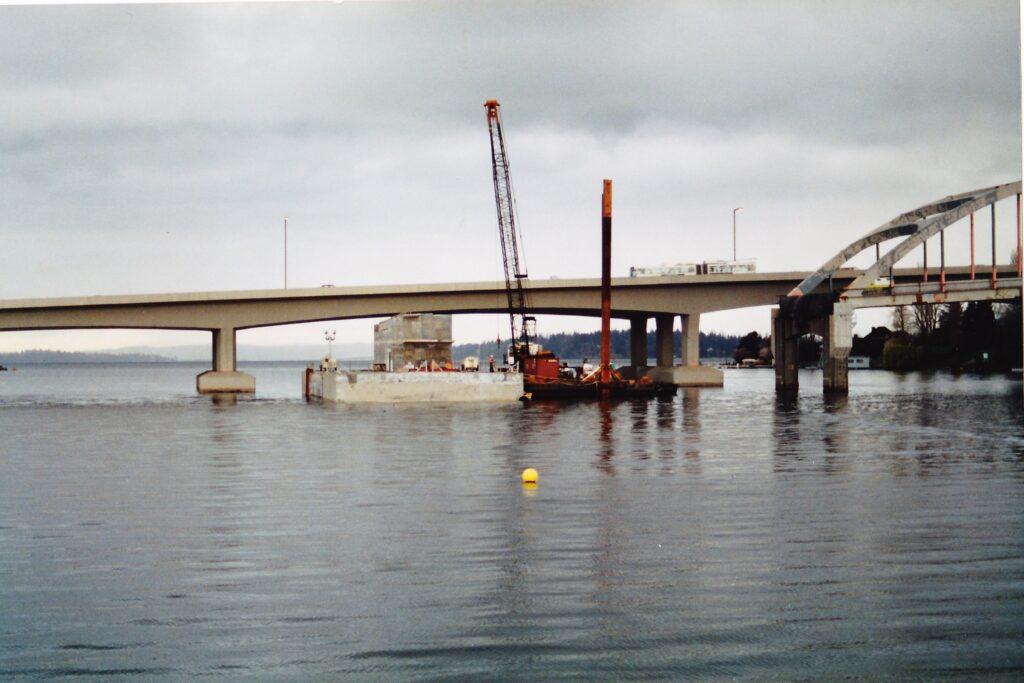
Inside the new bridge, it was a huge step forward over the old bridge. Full catwalks were incorporated – gone were the days of 2×6 planks. Full lighting was incorporated. Gravel ballast would be used – no more water. The new bridge would be dry as a bone inside.
Pumping systems were incorporated into the bridge. The bridge is divided into 4 cells width wise. Each cell has a sump and a pipe that is routed out of the north wall into the moat. If a cell were to fill with water, pumps could be used to pump it out. These are large Godwin pumps that could be located on the deck or on a boat. The crew can connect the pump from the work boat and water can be discharged into the lake. The limitation is the head required to pump the pontoon dry. As the water level is pumped down, more and more pump head is required to get the water out. Emergency pumps are intended to keep the bridge afloat by drawing down enough water until larger pumps could be brought on site.
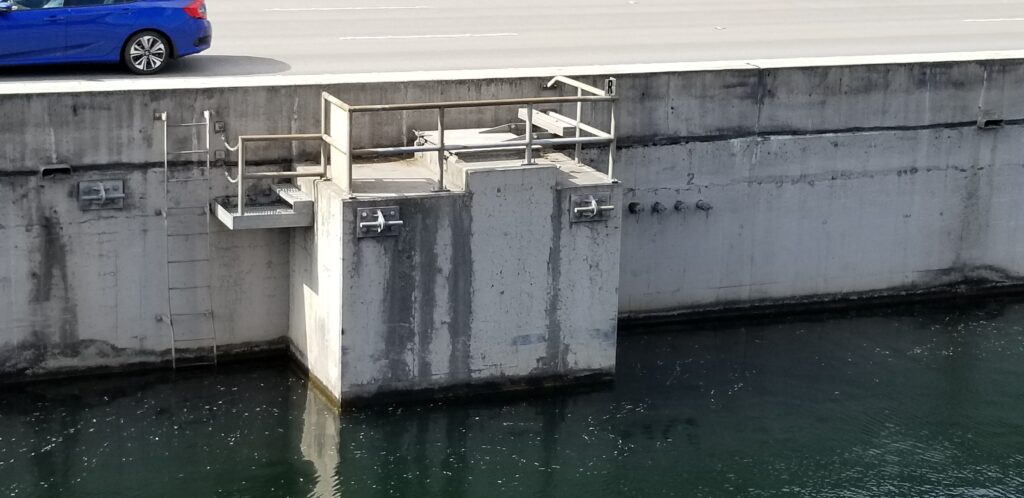
Another major feature was the improvement to the anchor gallery setup. The Third Lake Bridge was built in phases, with the majority of the non-highrise pontoons being built in Phase I. Phase I pontoons were built in the old style of Evergreen Point and the old Murrow Bridge – with common wall cable ways. This means that the transverse cable from the north is directly in line with the transverse cable from the south. They share a common wall. Phase II pontoons had offset wall cable ways – meaning the north and south cables were offset and did not share a common wall.
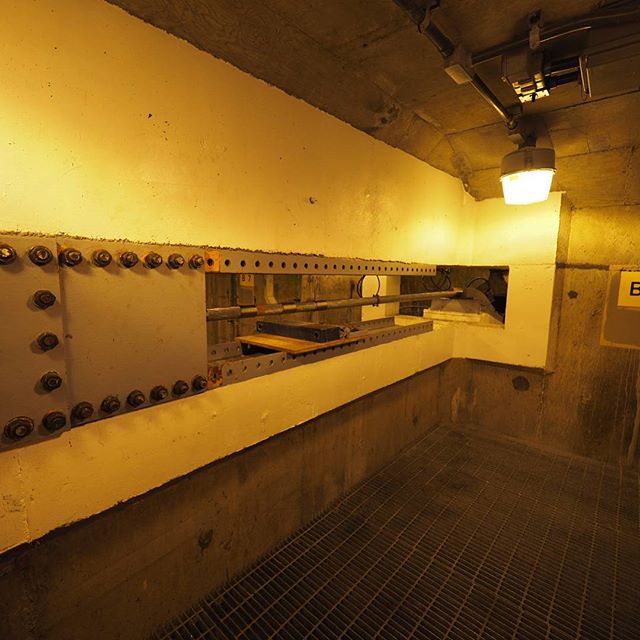
So why does that matter? A few reasons. On the Phase I pontoons, the common wall runs the width of the pontoon. Since cable adjustment means you have to adjust the shims on each side of the cable way, to get to the other side you’d have to crawl over the wall to get to the other side. Or go out and in through another hatch. It was kind of a pain.
On the Phase II pontoons, this was made easier by having offset cable ways. You could now get to both sides of one cable from the same cell. And you could get to the near side of the next cable. But you still had to crawl over the wall to get to the far side of the next cable. But it was progress.
On the new Murrow Bridge, the anchor galleries were an improvement over the Third Lake Phase II pontoons. Both cables in the gallery were now fully accessible from one hatch with no walls to crawl over. The floors of the anchor gallery were concrete rather than catwalk, much like Hood Canal.
The other benefit of offset cable ways was on cable adjustment. With a common cable way, cable length is extremely important. If cables are too long and the adjustment devices get too close together, it makes it impossible to take up or let the cable down because the other cable is in the way. With offset cables, this problem is eliminated. You could locate the cable anywhere on the track and be ok.
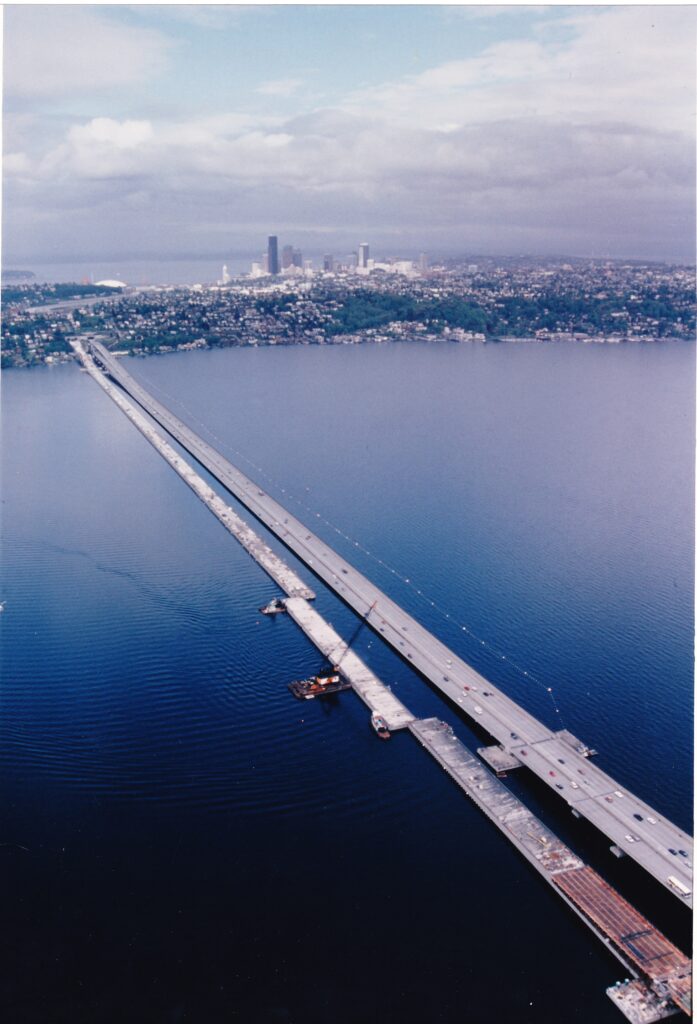
The new Murrow Bridge was opened on September 12, 1993 and 27 years on is doing well. Although it looks very similar to its predecessor, it incorporates many improvements in floating bridge design that have been learned in the 50 years since the original bridge was built. It even includes a few innovations over the newer bridge next to it. Indeed, lessons learned from its construction influenced the Hood Canal Bridge east half replacement project in 2009 and the Evergreen Point Bridge replacement in 2016.
Besides maintenance and upkeep, the bridge is virtually the same as it was when it opened in 1993. Unlike Hood Canal, which continually needs attention, the new bridge has been relatively problem free. And unlike the old Evergreen Point Bridge, nothing has been added to the bridge over the last 27 years to weigh it down in the water. The only change to the bridge was the addition of an extra High Occupancy Vehicle (HOV) lane in 2017 as a result of the I-90 express lanes going away to make way for light rail. The Murrow Bridge is happy to let Third Lake get retrofitted to carry light rail.
In 2023, WSDOT will complete the final round of anchor cable replacements on the bridge. These cables will have been in service since the early 1990’s and are at the end of their service life. Replacing these important elements helps ensure the bridge keeps on going for another 30 years.
Some of the communication systems on the bridge are nearing the end of their life. State of the art in the 1990’s, these systems are now obsolete and replacement parts are difficult or impossible to find. When the Evergreen Point Bridge was replaced, many spare parts from that bridge made their way to I-90. Some of the spare parts have been sourced from some unusual locations. The communications system used on the I-90 bridges is the same as was used on dairy farms for automated milking. As dairy farms upgrade their systems, the bridge crew is quick to pick up any spare parts they are willing to part with.
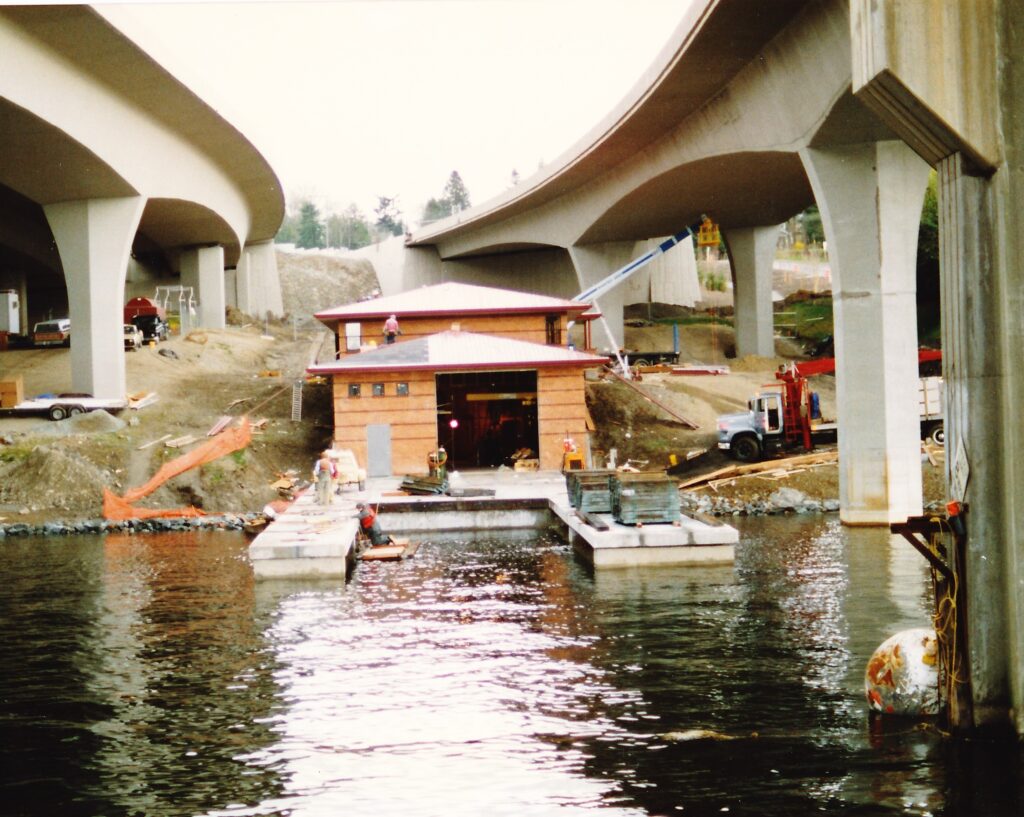
Prior to 1993, the maintenance crew that took care of the I-90 floating bridges was based out of a small house off of 72nd Avenue on Mercer Island. It was a small house that overlooked what would become the Mercer Island lid. Trucks and other equipment were based out of the Northup Way facility in Bellevue. When the new bridge was built, the maintenance crew moved up in the world with a new shop directly under the bridges and right on Lake Washington. This more convenient as it allowed for direct access to the work boat and better storage of equipment at the bridge.
The author has attempted to find out what happened to the old house. It was likely sold in 1997 to a couple who lived there until 2005. The house was then sold to a builder who demolished it in 2006 to make way for a new home with a tax assessed value of about $3 million!

That concludes this special November to remember, where we look back at the fascinating story of the First Lake Washington Bridge. I hope to be able to write more of these types of articles in the future. If you have any ideas for future blog articles related to the world of bridge engineering, let me know. If you enjoyed this series, please consider subscribing to my blog – TheBridgeGuy.org. Browse the shop for bridge related merchandise – great gift ideas for the bridge enthusiast in your life.
Own your own architectural print of the Lacey V. Murrow Memorial Bridge! Visit Etsy.com for details.
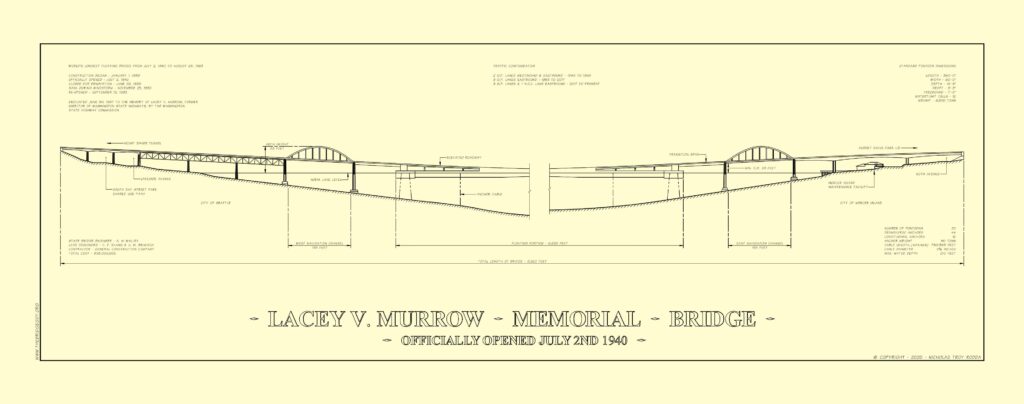
And this series would not be possible without the help of some talented folks who were there the day the bridge sank. Thanks to Jim Stonecipher, Bridge Maintenance Supervisor in charge of caring for the I-90 floating bridges. And to Patrick Clarke for his memorable stories and background on these bridges.
Special thanks to two guys who fondly remember working on the old Murrow Bridge, Rick Rodda and Steve Nilsen, former and current Northwest Region Bridge Superintendent. My Dad is one of the few people, in engineering or maintenance, who has worked on all four of the State’s floating bridges, including all of the ones that have since been replaced. Many of the photos provided in these blog posts were taken by my Dad 30 years ago.
Views: 1423
